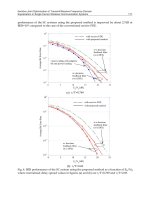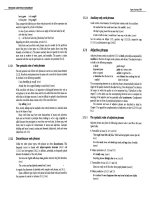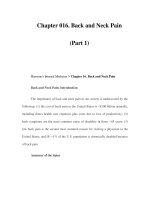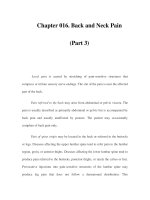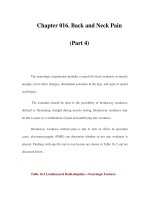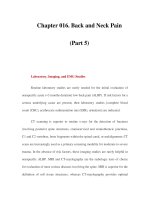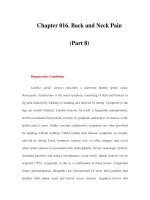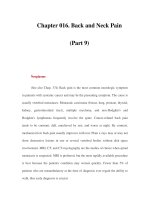Chapter 016. Back and Neck Pain (Part 10) pdf
Bạn đang xem bản rút gọn của tài liệu. Xem và tải ngay bản đầy đủ của tài liệu tại đây (11.43 KB, 4 trang )
Chapter 016. Back and Neck Pain
(Part 10)
Referred Pain from Visceral Disease
Diseases of the thorax, abdomen, or pelvis may refer pain to the posterior
portion of the spinal segment that innervates the diseased organ. Occasionally,
back pain may be the first and only manifestation. Upper abdominal diseases
generally refer pain to the lower thoracic or upper lumbar region (eighth thoracic
to the first and second lumbar vertebrae), lower abdominal diseases to the mid-
lumbar region (second to fourth lumbar vertebrae), and pelvic diseases to the
sacral region. Local signs (pain with spine palpation, paraspinal muscle spasm) are
absent, and little or no pain accompanies routine movements of the spine.
Low Thoracic or Lumbar Pain with Abdominal Disease
Peptic ulcers or tumors of the posterior wall of the stomach or duodenum
typically produce epigastric pain (Chaps. 87 and 287), but midline back or
paraspinal pain may occur if retroperitoneal extension is present. Fatty foods are
more likely to induce back pain associated with biliary disease. Diseases of the
pancreas produce back pain to the right of the spine (head of the pancreas
involved) or to the left (body or tail involved). Pathology in retroperitoneal
structures (hemorrhage, tumors, pyelonephritis) produces paraspinal pain that
radiates to the lower abdomen, groin, or anterior thighs. A mass in the iliopsoas
region often produces unilateral lumbar pain with radiation toward the groin, labia,
or testicles. The sudden appearance of lumbar pain in a patient receiving
anticoagulants suggests retroperitoneal hemorrhage.
Isolated low back pain occurs in 15–20% of patients with a contained
rupture of an abdominal aortic aneurysm (AAA). The classic clinical triad of
abdominal pain, shock, and back pain occurs in <20% of patients. Two of these
three features are present in two-thirds of patients, and hypotension is present in
half. The typical patient is an elderly male smoker with back pain. Frequently, the
diagnosis is initially missed because the symptoms and signs can be nonspecific.
Common misdiagnoses include nonspecific back pain, diverticulitis, renal colic,
sepsis, and myocardial infarction. A careful abdominal examination revealing a
pulsatile mass (present in 50–75% of patients) is an important physical finding.
Patients with suspected AAA should be evaluated with abdominal ultrasound, CT,
or MRI (Chap. 242).
Inflammatory bowel disorders (colitis, diverticulitis) or cancers of the colon
may produce lower abdominal pain, midlumbar back pain, or both. The pain may
have a beltline distribution around the body. A lesion in the transverse or proximal
descending colon may refer pain to the mid or left back at the L2-L3 level. Lesions
of the sigmoid colon may refer pain to the upper sacral or midline suprapubic
regions or left lower quadrant of the abdomen.
Sacral Pain with Gynecologic and Urologic Disease
Pelvic organs rarely cause low back pain, except for gynecologic disorders
involving the uterosacral ligaments. The pain is referred to the sacral region.
Endometriosis or uterine cancers may invade the uterosacral ligaments. Pain
associated with endometriosis is typically premenstrual and often continues until it
merges with menstrual pain. Uterine malposition may cause uterosacral ligament
traction (retroversion, descensus, and prolapse)or produce sacral pain after
prolonged standing.
Menstrual pain may be felt in the sacral region. The poorly localized,
cramping pain can radiate down the legs. Pain due to neoplastic infiltration of
nerves is typically continuous, progressive in severity, and unrelieved by rest at
night. Less commonly, radiation therapy of pelvic tumors may produce sacral pain
from late radiation necrosis of tissue or nerves. Low back pain that radiates into
one or both thighs is common in the last weeks of pregnancy.
Urologic sources of lumbosacral back pain include chronic prostatitis,
prostate cancer with spinal metastasis (Chap. 91), and diseases of the kidney and
ureter. Lesions of the bladder and testes do not usually produce back pain.
Infectious, inflammatory, or neoplastic renal diseases may produce ipsilateral
lumbosacral pain, as can renal artery or vein thrombosis. Paraspinal lumbar pain
may be a symptom of ureteral obstruction due to nephrolithiasis.
Other Causes of Back Pain
Postural Back Pain
There is a group of patients with nonspecific chronic low back pain (CLBP)
in whom no anatomic lesion can be found despite exhaustive investigation. These
individuals complain of vague, diffuse back pain with prolonged sitting or
standing that is relieved by rest. The physical examination is unrevealing except
for "poor posture." Imaging studies and laboratory evaluations do not identify a
specific cause. Exercises to strengthen the paraspinal and abdominal muscles are
sometimes helpful.


